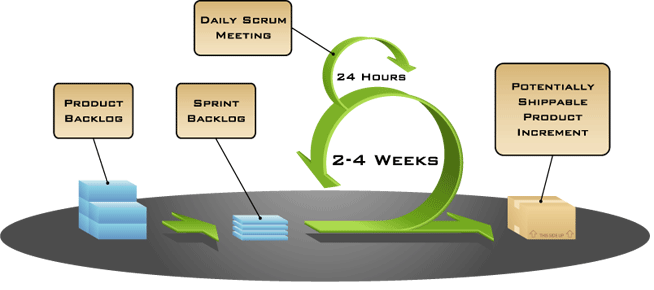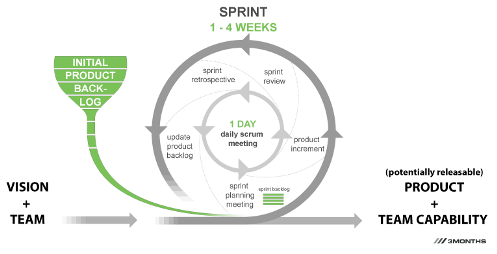Instead of starting my Sunday writing down the ideas for a book gathered in my mind over night, I sat in the garden, ate a watermelon, and let my thoughts settle until the sun chased me away. Because these days I need to revisit the knowledge that I have about SCRUM project management, I took it from the beginning.
Definition of a project, regardless of the source (PMBOK, Agile, etc.) revolves around the idea that an activity that takes place for in a certain period of time creates a tangible result.
If you look at every day of your life … don’t you wish all your actions which you start with a purpose to have the desired result as quickly as possible!?
A picture is worth more than many words. SCRUM:

Image source: www.mountaingoatsoftware.com/scrum
I remember the first time when I saw the picture above. I didn’t understand anything. Over time, it began to make sense mostly because it was similar with what happened in everyday life:
You have a long list of things to do that you divide into smaller lists.
You set a time frame (say a month) in which you take RESPONSIBILITY that you will do those things.
You check your progress by asking 3 questions:
- What I have done yesterday?
- What I will do today?
- What is stopping me from making things happens?
At the end of that time period you should have or done the thing you planned for.
Of course, when this happens in a company with a team it requires more organization and a minimum of procedures. You must define the roles that team members have, the types of activities, and tools you use.
Roles:
- Product Owner
- Scrum Master
- Scrum Team
Activities:
- Sprint Planning
- Daily Scrums
- Sprint Review
Tools:
- Product Backlog
- Sprint Backlog
- Burndown Charts
I’ll start with a short description of what each represents, in reverse order:
Burndown Chart – method to monitor (graphic) work in progress within a Sprint. Initially it is the total amount of work that diminishes over time within each iteration (sprint segment of usually one day).
Sprint Backlog – list of requirements to be fulfilled in a defined time interval (Sprint)
Product Backlog – list of features that the final product should have. Extracted from this is the list of requirements for Sprint.
Sprint Review – a meeting that takes place at the end of a sprint in which you review the functionalities of the product completed, usually in the form of a demo. Some teams also participate in a meeting called Sprint Retrospective intended for internal analysis of the activity in that sprint.
Daily Scrum – a meeting that takes place every day in which members respond to three questions:
1. What did you do yesterday?
2. What will you do today?
3. There are issues that can prevent you from achieving your goal for which you took responsibility?
Sprint Planning – initial team meeting. It has two parts: in the first part the priority functionalities are set in Product Backlog and the Sprint Backlog is created second.
Scrum Team – team
Scrum Master – Project Manager. In SCRUM there is no manager in the hierarchical sense of the word.
Product Owner – customer representative, responsible for prioritizing functionalities in Backlog.
SCRUM process at a glance:
A Product Owner creates a Product Backlog based on customer requirements. These requirements are discussed with the team, Scrum Team, defined as features (functionalities) and prioritized.
Then there is a meeting, Sprint Planning. During this meeting the team chooses features that will be developed under a previous Sprint in a list called Sprint Backlog.
In a Sprint there are Daily Scrum meetings daily discussing things made the day before and what will be done that day.
At the end of a Sprint takes place a meeting assessing what was done: Sprint Review, and sometimes a Sprint Retrospective.
The process begins again with a new Sprint Backlog.
Here’s a picture describing SCRUM process in a different way, but more relevant for the explanations so far:

Image source: Illustrating Scrum – A New and Improved Scrum Diagram
Instead of conclusion I recommend you to watch a presentation made by Ken Schwaber during Google Tech Talks.
